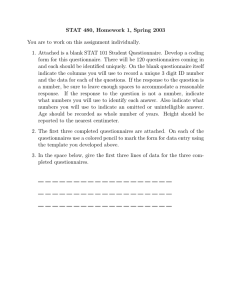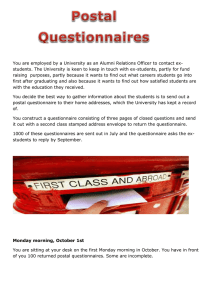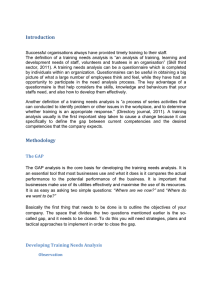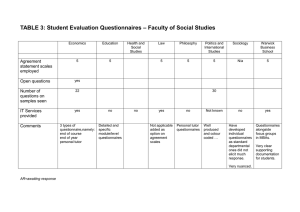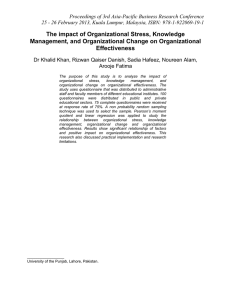BOS Best Practice Guidelines (updated Nov 2014)
advertisement
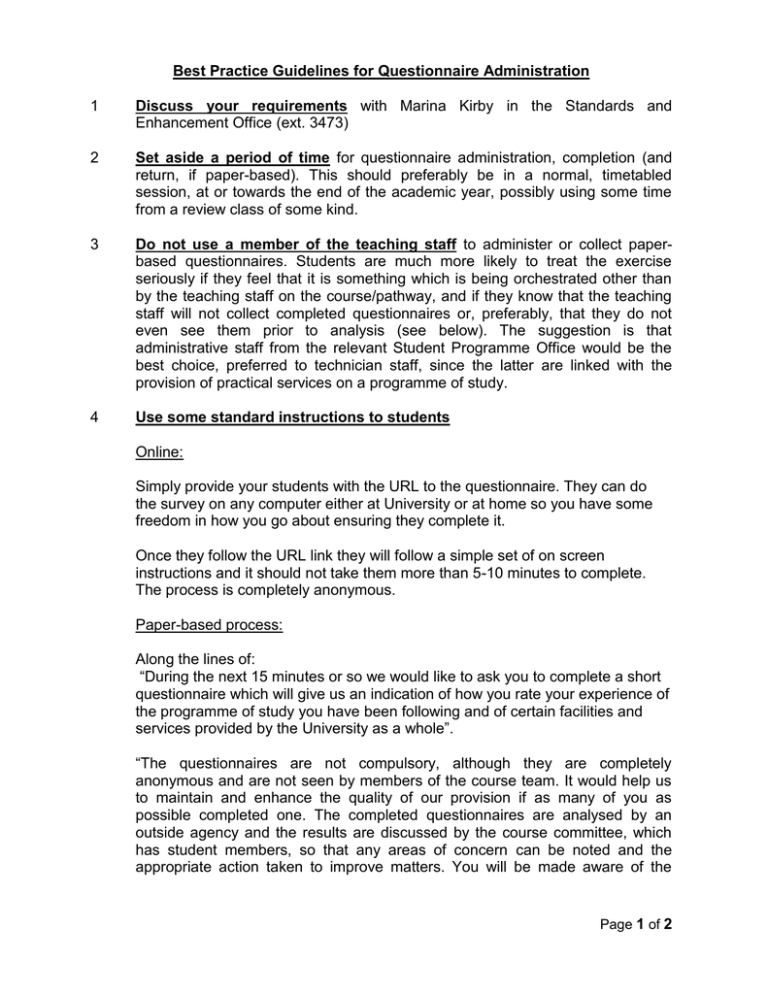
Best Practice Guidelines for Questionnaire Administration 1 Discuss your requirements with Marina Kirby in the Standards and Enhancement Office (ext. 3473) 2 Set aside a period of time for questionnaire administration, completion (and return, if paper-based). This should preferably be in a normal, timetabled session, at or towards the end of the academic year, possibly using some time from a review class of some kind. 3 Do not use a member of the teaching staff to administer or collect paperbased questionnaires. Students are much more likely to treat the exercise seriously if they feel that it is something which is being orchestrated other than by the teaching staff on the course/pathway, and if they know that the teaching staff will not collect completed questionnaires or, preferably, that they do not even see them prior to analysis (see below). The suggestion is that administrative staff from the relevant Student Programme Office would be the best choice, preferred to technician staff, since the latter are linked with the provision of practical services on a programme of study. 4 Use some standard instructions to students Online: Simply provide your students with the URL to the questionnaire. They can do the survey on any computer either at University or at home so you have some freedom in how you go about ensuring they complete it. Once they follow the URL link they will follow a simple set of on screen instructions and it should not take them more than 5-10 minutes to complete. The process is completely anonymous. Paper-based process: Along the lines of: “During the next 15 minutes or so we would like to ask you to complete a short questionnaire which will give us an indication of how you rate your experience of the programme of study you have been following and of certain facilities and services provided by the University as a whole”. “The questionnaires are not compulsory, although they are completely anonymous and are not seen by members of the course team. It would help us to maintain and enhance the quality of our provision if as many of you as possible completed one. The completed questionnaires are analysed by an outside agency and the results are discussed by the course committee, which has student members, so that any areas of concern can be noted and the appropriate action taken to improve matters. You will be made aware of the Page 1 of 2 outcomes of the survey and of the action taken in response”. (Preferably say how this will be done). “All that is required of you is to complete the questionnaire by ticking the appropriate response and sometimes by writing in some additional information. If any question is not relevant or you do not want to answer then please leave it blank. Questionnaires will be collected at the end”. “Are there any questions or problems?” 5 Respond appropriately to any questions or problems raised prior to or during completion of the questionnaires. 6 Thank the students for their help and co-operation (whilst collecting in the completed questionnaires). 7 Return completed paper-based questionnaires (along with a completed ‘batch cover sheet’ and a copy of an official purchase order to the Quality Assurance Administrator (Enhancement and Governance) in Quality Assurance and Enhancement Unit, who will arrange processing. Reports will normally be available within 6-8 working days. Additional reports may be requested subsequently, at cost to the School/Centre. Online results are available instantly. 8 Reminders for online questionnaires For online questionnaires you will probably need to give students a reminder either in class or by email. Response rates do increase following such reminders, although they do of course suffer diminishing returns. Fortnightly seem to work best. Remember to thank those who have already completed the questionnaire and explain that because the questionnaire is anonymous the reminder includes them as well, for which apologies should be made. 9 Discuss the result with students! The questionnaires are only a tool used to identify issues which warrant further exploration with the students. Discussion of the results can help to clarify the underlying causes of any dissatisfaction expressed (sometimes these are different for different students), to correct any misunderstandings (on either ‘side’), and to aid in the development of an action plan. 10 Develop an action plan to address substantial dissatisfaction. The plan should contain objectives, which are Specific, Measurable, Achievable, Realistic and Time-related (SMART). The plan should also be monitored, and reviewed from time to time as further feedback from students is obtained. It should be fed back to students so that each one is aware what is being done to address their concerns. L:\AQAS\Contensis Documents\Uploaded documents 2014-15\Student Questionnaires\BestPracticeGuidelines(updatedNov2014).doc Page 2 of 2
